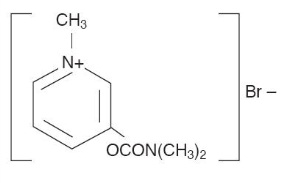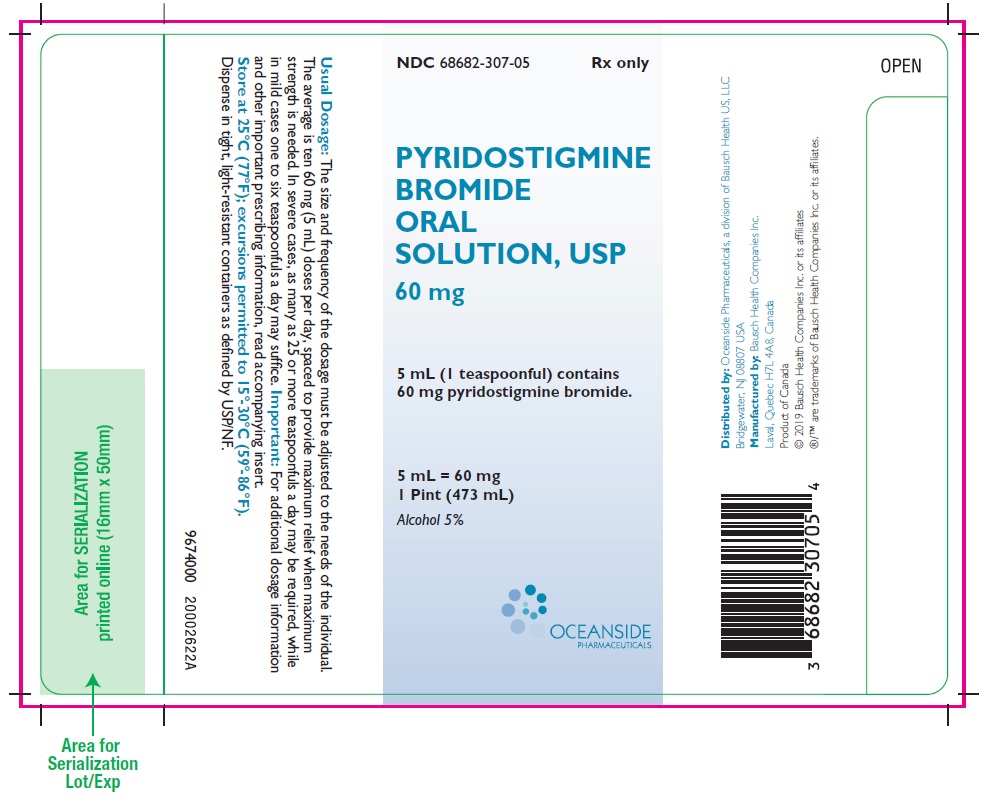PYRIDOSTIGMINE BROMIDE solution
pyridostigmine bromide by
Drug Labeling and Warnings
pyridostigmine bromide by is a Prescription medication manufactured, distributed, or labeled by Oceanside Pharmaceuticals, Bausch Health Companies Inc.. Drug facts, warnings, and ingredients follow.
Drug Details [pdf]
-
DESCRIPTION:
Pyridostigmine Bromide Oral Solution, USP is an orally active cholinesterase inhibitor. Chemically, pyridostigmine bromide is 3-hydroxy-1-methylpyridinium bromide dimethylcarbamate. Its structural formula is:
Pyridostigmine bromide is available in the following forms: Oral Solution containing 60 mg pyridostigmine bromide per teaspoonful in a vehicle containing 5% alcohol, glycerin, lactic acid, sodium benzoate, sorbitol, sucrose, FD&C Red No. 40, FD&C Blue No. 1, flavors and water. Tablets containing 60 mg pyridostigmine bromide; each tablet also contains lactose, silicon dioxide and stearic acid. Timespan Tablets containing 180 mg pyridostigmine bromide; each tablet also contains carnauba wax, corn-derived proteins, magnesium stearate, silica gel and tribasic calcium phosphate.
-
ACTIONS:
Pyridostigmine bromide inhibits the destruction of acetylcholine by cholinesterase and thereby permits freer transmission of nerve impulses across the neuromuscular junction. Pyridostigmine is an analog of neostigmine (Prostigmin™), but differs from it in certain clinically significant respects; for example, pyridostigmine is characterized by a longer duration of action and fewer gastrointestinal side effects.
- INDICATION:
- CONTRAINDICATIONS:
-
WARNINGS:
Although failure of patients to show clinical improvement may reflect underdosage, it can also be indicative of overdosage. As is true of all cholinergic drugs, overdosage of Pyridostigmine Bromide Oral Solution may result in cholinergic crisis, a state characterized by increasing muscle weakness which, through involvement of the muscles of respiration, may lead to death. Myasthenic crisis due to an increase in the severity of the disease is also accompanied by extreme muscle weakness, and thus may be difficult to distinguish from cholinergic crisis on a symptomatic basis. Such differentiation is extremely important, since increases in doses of Pyridostigmine Bromide Oral Solution or other drugs of this class in the presence of cholinergic crisis or of a refractory or “insensitive” state could have grave consequences. Osserman and Genkins1 indicate that the differential diagnosis of the two types of crisis may require the use of Tensilon™ (edrophonium chloride) as well as clinical judgment. The treatment of the two conditions obviously differs radically. Whereas the presence of myasthenic crisis suggests the need for more intensive anticholinesterase therapy, the diagnosis of cholinergic crisis, according to Osserman and Genkins1, calls for the prompt withdrawal of all drugs of this type. The immediate use of atropine in cholinergic crisis is also recommended.
Atropine may also be used to abolish or obtund gastrointestinal side effects or other muscarinic reactions; but such use, by masking signs of overdosage, can lead to inadvertent induction of cholinergic crisis.
For detailed information on the management of patients with myasthenia gravis, the physician is referred to one of the excellent reviews such as those by Osserman and Genkins, 2 Grob3 or Schwab.4,5
Usage in Pregnancy:
The safety of Pyridostigmine Bromide Oral Solution, USP during pregnancy or lactation in humans has not been established. Therefore, use of Pyridostigmine Bromide Oral Solution in women who may become pregnant requires weighing the drug’s potential benefits against its possible hazards to mother and child.
- PRECAUTION:
-
ADVERSE REACTIONS:
The side effects of Pyridostigmine Bromide Oral Solution, USP are most commonly related to overdosage and generally are of two varieties, muscarinic and nicotinic. Among those in the former group are nausea, vomiting, diarrhea, abdominal cramps, increased peristalsis, increased salivation, increased bronchial secretions, miosis and diaphoresis. Nicotinic side effects are comprised chiefly of muscle cramps, fasciculation and weakness. Muscarinic side effects can usually be counteracted by atropine, but for reasons shown in the preceding section the expedient is not without danger. As with any compound containing the bromide radical, a skin rash may be seen in an occasional patient. Such reactions usually subside promptly upon discontinuance of the medication.
To report SUSPECTED ADVERSE REACTIONS, contact Bausch Health US, LLC, at 1-800-321-4576 or FDA at 1-800-FDA-1088 or www.fda.gov/medwatch.
-
DOSAGE AND ADMINISTRATION:
Pyridostigmine bromide is available in three dosage forms:
Oral Solution -
raspberry-flavored, containing 60 mg pyridostigmine bromide per teaspoonful (5 mL). This form permits accurate dosage adjustment for children and “brittle” myasthenic patients who require fractions of 60 mg doses. It is more easily swallowed, especially in the morning, by patients with bulbar involvement.
Timespan Tablets -
each containing 180 mg pyridostigmine bromide. This form provides uniformly slow release, hence prolonged duration of drug action; it facilitates control of myasthenic symptoms with fewer individual doses daily. The immediate effect of a 180 mg Timespan Tablet is about equal to that of a 60 mg Conventional Tablet; however, its duration of effectiveness, although varying in individual patients, averages 2½ times that of a 60 mg dose.
Dosage:
The size and frequency of the dosage must be adjusted to the needs of the individual patient.
Oral Solution and Conventional Tablets -
The average dose is ten 60 mg tablets or ten 5 mL teaspoonfuls daily, spaced to provide maximum relief when maximum strength is needed. In severe cases as many as 25 tablets or teaspoonfuls a day may be required, while in mild cases one to six tablets or teaspoonfuls a day may suffice.
Timespan Tablets -
One to three 180 mg tablets, once or twice daily, will usually be sufficient to control symptoms; however, the needs of certain individuals may vary markedly from this average. The interval between doses should be at least 6 hours. For optimum control, it may be necessary to use the more rapidly acting regular tablets or oral solution in conjunction with Timespan therapy.
NOTE: For information on a diagnostic test for myasthenia gravis, and for the evaluation and stabilization of therapy, please see product literature on Tensilon (edrophonium chloride).
-
HOW SUPPLIED:
Oral Solution, 60 mg pyridostigmine bromide per teaspoonful (5 mL) and 5% alcohol - bottles of 16 fluid ounces (1 pint) (NDC: 68682-307-05).
Tablets, 60 mg pyridostigmine bromide each - bottles of 100 NDC: 68682-302-10.
Timespan Tablets, 180 mg pyridostigmine bromide each - bottles of 30 NDC: 68682-301-30.
Note: Because of the hygroscopic nature of the Timespan Tablets, mottling may occur. This does not affect their efficacy. -
REFERENCES:
- 1. Osserman KE, Genkins G. Studies in myasthenia gravis: Reduction in mortality rate after crisis. JAMA. Jan 1963; 183:97-101.
- 2. Osserman KE, Genkins G. Studies in myasthenia gravis. NY State J Med. June 1961; 61:2076-2085.
- 3. Grob D. Myasthenia gravis. A review of pathogenesis and treatment. Arch Intern Med. Oct 1961; 108:615-638.
- 4. Schwab RS. Management of myasthenia gravis. New Eng J Med. Mar 1963; 268:596-597.
- 5. Schwab RS. Management of myasthenia gravis. New Eng J Med. Mar 1963; 268:717-719.
- 6. Cronnelly R, Stanski DR, Miller RD, Sheiner LB. Pyridostigmine kinetics with and without renal function. Clin Pharmacol Ther. 1980; 28:No. 1, 78-81.
- 7. Miller RD. Pharmacodynamics and pharmacokinetics of anticholinesterase. In: Ruegheimer E, Zindler M, ed. Anaesthesialagy. (Hamburg, Germany: Congress; Sep 14-21, 1980; 222-223.) (Int Congr. No. 538), Amsterdam, Netherlands: Excerpta Medica; 1981.
- 8. Breyer-Pfaff U, Maier U, Brinkmann AM, Schumm F. Pyridostigmine kinetics in healthy subjects and patients with myasthenia gravis. Clin Pharmacol Ther. 1985;5:495-501.
-
SPL UNCLASSIFIED SECTION
Distributed by: Oceanside Pharmaceuticals, a division of
Bausch Health US, LLC
Bridgewater, NJ 08807 USA-
Manufactured by:
Bausch Health Companies Inc.
Laval, Quebec H7L 4A8, Canada
© 2019 Bausch Health Companies Inc. or its affiliates
®/™ are trademarks of Bausch Health Companies Inc. or its affiliates.
9674000 20002622A Rev. 04/2019
-
Manufactured by:
- PRINCIPAL DISPLAY PANEL - 473 mL Bottle Label
-
INGREDIENTS AND APPEARANCE
PYRIDOSTIGMINE BROMIDE
pyridostigmine bromide solutionProduct Information Product Type HUMAN PRESCRIPTION DRUG Item Code (Source) NDC: 68682-307 Route of Administration ORAL Active Ingredient/Active Moiety Ingredient Name Basis of Strength Strength pyridostigmine bromide (UNII: KVI301NA53) (pyridostigmine - UNII:19QM69HH21) pyridostigmine bromide 60 mg in 5 mL Inactive Ingredients Ingredient Name Strength alcohol (UNII: 3K9958V90M) glycerin (UNII: PDC6A3C0OX) LACTIC ACID, UNSPECIFIED FORM (UNII: 33X04XA5AT) sodium benzoate (UNII: OJ245FE5EU) sorbitol (UNII: 506T60A25R) sucrose (UNII: C151H8M554) FD&C Red No. 40 (UNII: WZB9127XOA) FD&C Blue No. 1 (UNII: H3R47K3TBD) water (UNII: 059QF0KO0R) Product Characteristics Color Score Shape Size Flavor RASPBERRY Imprint Code Contains Packaging # Item Code Package Description Marketing Start Date Marketing End Date 1 NDC: 68682-307-05 473 mL in 1 BOTTLE; Type 0: Not a Combination Product 07/01/2019 Marketing Information Marketing Category Application Number or Monograph Citation Marketing Start Date Marketing End Date NDA authorized generic NDA015193 07/01/2019 Labeler - Oceanside Pharmaceuticals (832011691) Establishment Name Address ID/FEI Business Operations Bausch Health Companies Inc. 245141858 MANUFACTURE(68682-307)
© 2025 FDA.report
This site is not affiliated with or endorsed by the FDA.

